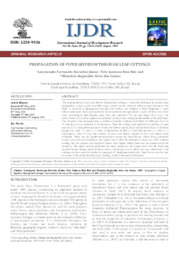Propagation of piper hispidum through leaf cuttings.
Propagation of piper hispidum through leaf cuttings.
Autoria: DORNELES JÚNIOR, L. F.; BISI, E. J. R.; SANTOS, M. R. A. dos
Resumo: The regeneration of roots and shoots through leaf cuttings is a feasible technique for plant clonal propagation, using a quite available organ, which can be collected without great damage to the plant. A protocol of propagation through leaf cuttings was defined to Piper hispidum, a plant whose compounds have great potential use in medicine and agriculture. Leaves of three sizes were used, according to their length: small (4-6 cm), medium (7-9 cm) and large (10-12 cm). The leaves were cut in halves (apical and petiolar) by transverse cutting in the middle of the leaf blade. The cut parts were immersed into a solution of indole 3-butyric acid (IBA) at 1000 ppm for 5 or 20 minutes, or not submitted to the hormone. Then the cuttings were planted in a mixture of sand and soil (1:1), using three positions of the leaf halves: apical, basal and inverted basal. A factorial design was used – 3 sizes x 3 times of immersion in IBA x 3 leaf half position x 3 blocs x 3 replications. After 82 days the number of roots and shoots, length of roots and shoots were evaluated. There was no significant interaction among the three factors. Small leaves produced longer roots and more numerous and longer shoots than the medium or large ones. IBA induced rooting, but the number and length of shoots were higher where there was no immersion in the hormone. The apical portion generated far more numerous and longer roots, but the basal and inverted basal cuttings produced more shoots, which gave rise to their own roots afterwards. Leaf cuttings can be a practical method to propagate P. hispidumvegetatively. Small leaves can be used as source of basal and inverted basal cuttings, without treatment with auxin.
Ano de publicação: 2018
Tipo de publicação: Artigo de periódico
Unidade: Embrapa Rondônia
Palavras-chave: Clonal propagation, Leaf cuttings, Leaf rooting
Observações
1 - Por padrão são exibidas publicações dos últimos 20 anos. Para encontrar publicações mais antigas, configure o filtro ano de publicação, colocando o ano a partir do qual você deseja encontrar publicações. O filtro está na coluna da esquerda na busca acima.
2 - Para ler algumas publicações da Embrapa (apenas as que estão em formato ePub), é necessário ter, no celular ou computador, um desses softwares gratuitos. Sistemas Android: Google Play Livros; IOS: iBooks; Windows e Linux: software Calibre.
Acesse outras publicações
Acesse a Base de Dados da Pesquisa Agropecuária (BDPA) para consultar o acervo completo das bibliotecas da Embrapa.

